Pickles are a beloved food item all around the world. From the crunchy dill pickles in the United States to the tangy achaar pickles in India, there is no shortage of pickle varieties to choose from. But have you ever tried fermented pickles? Fermented pickles are a healthier and more delicious version of the classic pickle, and they’re easy to make at home! In this article, we’ll explore what fermented pickles are and how they’re preserved. We will also explore seven healthy and delicious fermented pickle recipes.
What are Fermented Pickles?
Fermented pickles are pickles that have been preserved using lacto-fermentation. This is a natural process that involves the use of bacteria to break down the natural sugars in the food, creating lactic acid. This acid acts as a natural preservative, which further extends the shelf life of the food.
Fermented pickles are different from traditional pickles in that they are not preserved using vinegar. Instead, they rely on the natural bacteria present on the food to start the fermentation process. This process results in a tangy and slightly sour flavor, which many people find more appealing than the overly sour taste of vinegar-based pickles.
What is the process for preserving them?
Fermented pickles are preserved using lacto-fermentation. This process involves placing the food in a brine solution made up of water, salt, and sometimes spices. The salt creates an environment inhospitable to harmful bacteria, while the spices add flavor and depth to the pickles.
The food is then left to sit at room temperature for several days or even weeks, depending on the recipe. During this time, the natural bacteria on the food will start to break down the natural sugars, creating lactic acid. This acid lowers the pH of the brine, making it more acidic and creating an environment that is even more inhospitable to harmful bacteria.
In order to slow down the fermentation process and extend pickles’ shelf life, store them in a cool, dark place after fermentation is complete.
7 Healthy Fermented Pickle Recipes
1. Classic Dill Pickles
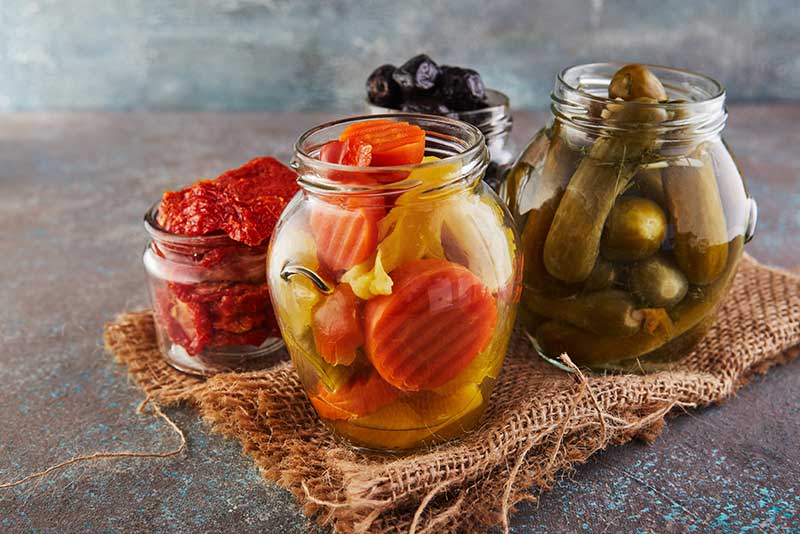
Ingredients:
- 2-3 cucumbers, sliced
- 2 cloves garlic, minced
- 1 tbsp dill seeds
- 1 tbsp black peppercorns
- 1 tbsp sea salt
- Filtered water
Instructions:
- Mix together the cucumbers, garlic, dill seeds, and black peppercorns in a large jar.
- In a separate bowl, dissolve the sea salt in filtered water to create a brine solution.
- Pour the brine over the cucumbers in the jar, making sure they are fully covered.
- Cover the jar with a lid or cheesecloth and leave it at room temperature for 3-5 days, or until the pickles reach your desired level of tanginess.
- Store the fermented pickles in the refrigerator to further slow down the fermentation process.
2. Indian Spicy Mango Pickles (Achaar)
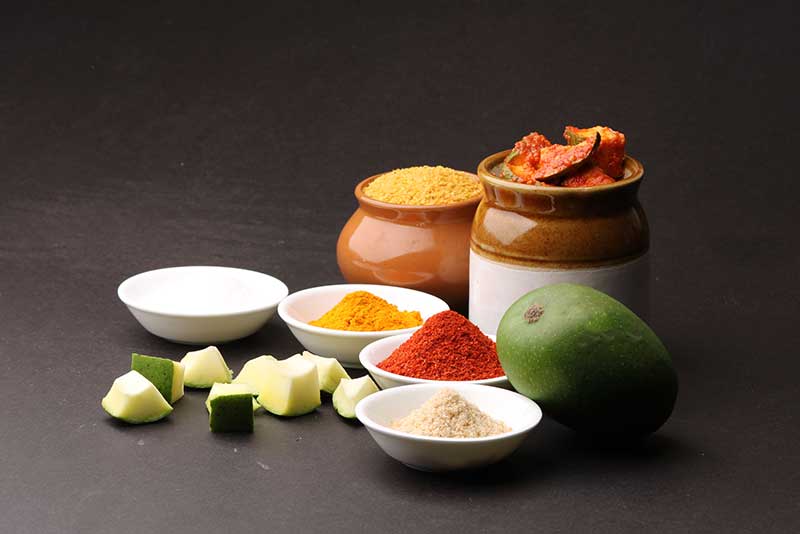
Ingredients:
- 2 medium-sized raw mangoes, peeled and cut into small pieces
- 2 tbsp salt
- 1 tbsp red chili powder
- 1/2 tbsp turmeric powder
- 1 tbsp mustard seeds
- 1/2 tbsp fenugreek seeds
- 1/2 tbsp fennel seeds
- 1/2 tbsp cumin seeds
- 1/2 tbsp coriander seeds
- 1/2 tbsp nigella seeds
- 1/2 cup mustard oil
Instructions:
- Wash and dry the mangoes, then cut them into small pieces and place them in a clean, dry bowl.
- Sprinkle salt over the mango pieces and mix well. Set the bowl aside for 4-5 hours to allow the mangoes excess moisture to evaporate.
- Lightly toast the seeds of mustard, fenugreek, fennel, cumin, coriander, and nigella in a dry skillet over low heat. Allow them to cool, then grind them to a fine powder in a spice grinder or blender.
- Add the red chili powder and turmeric powder to the ground spice mixture and mix well.
- Once the mangoes have released excess moisture, drain any liquid from the bowl and transfer the mango pieces to a clean, dry glass jar.
- Pour the spice mixture over the mangoes and mix well, making sure all the mango pieces are coated with the spice mixture.
- Heat the mustard oil in a small saucepan until it begins to smoke, then remove it from the heat and allow it to cool to room temperature.
- Pour the cooled mustard oil over the mango and spice mixture in the jar, making sure the mangoes are fully submerged in the oil.
- Cover the jar tightly and place it in a sunny spot for 5-6 days, stirring the mixture once a day. The pickle will start to ferment and develop its characteristic tangy flavor.
- After 5-6 days, taste the pickle and adjust the salt and spice levels as needed. The pickle can be stored in the refrigerator for up to 6 months.
3. Korean Kimchi
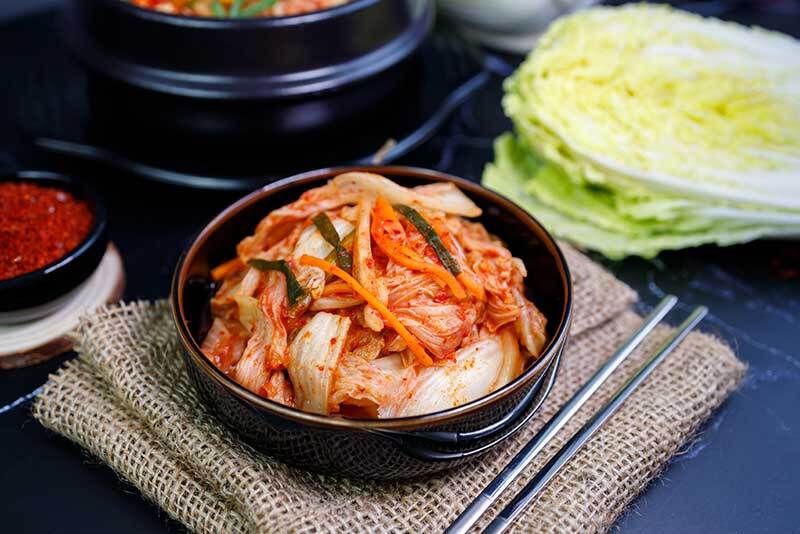
Ingredients:
- 1 head of Napa cabbage, chopped
- 1 bunch green onions, chopped
- 1/4 cup Korean red pepper flakes
- 1 tbsp ginger, grated
- 4 cloves garlic, minced
- 1 tbsp sea salt
- Filtered water
Instructions:
- Mix together the chopped cabbage, green onions, Korean red pepper flakes, ginger, garlic, and sea salt in a large bowl.
- Massage the mixture with your hands for a few minutes, until the vegetables start to release their juices.
- Pack the mixture tightly into a large jar, making sure there are no air pockets.
- Pour filtered water over the top of the vegetables, leaving about an inch of space at the top of the jar.
- Cover the jar with a lid or cheesecloth and leave it at room temperature for 3–5 days, or until the kimchi reaches your desired level of tanginess.
- Store the kimchi in the refrigerator to further slow down the fermentation process. This fermented pickle recipe will also help you master the art of preparing traditional Korean kimchi.
4. Fermented Carrots
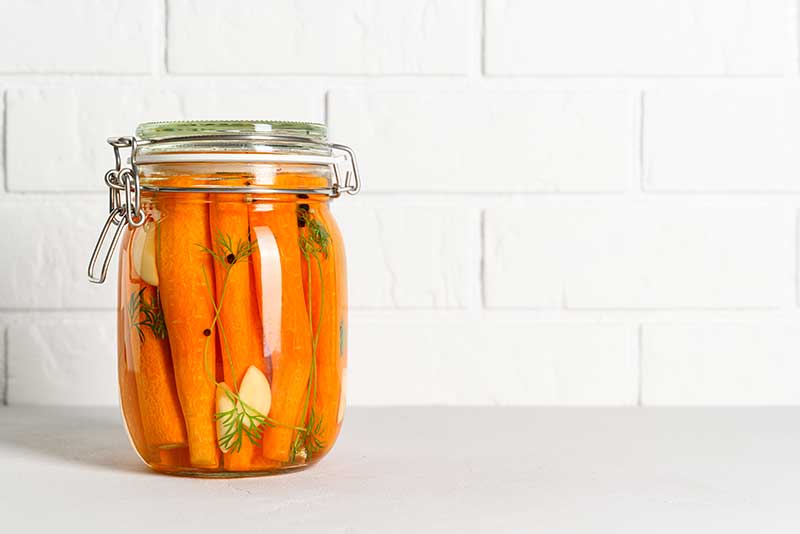
Ingredients:
- 2-3 carrots, sliced
- 2 cloves of garlic, minced
- 1 tbsp ginger, grated
- 1 tbsp sea salt
- Filtered water
Instructions:
- Mix together the sliced carrots, garlic, ginger, and sea salt in a large jar.
- In a separate bowl, dissolve the sea salt in filtered water to create a brine solution.
- Pour the brine over the carrots in the jar, making sure they are fully covered.
- Cover the jar with a lid or cheesecloth and leave it at room temperature for 3–5 days, or until the carrots reach your desired level of tanginess.
- Store the pickles in the refrigerator to further slow down the fermentation process.
5. Fermented Beets

Ingredients:
- 2-3 beets, sliced
- 2 cloves of garlic, minced
- 1 tbsp dill seeds
- 1 tbsp sea salt
- Filtered water
Instructions:
- Mix together the sliced beets, garlic, dill seeds, and sea salt in a large jar.
- In a separate bowl, dissolve the sea salt in filtered water to create a brine solution.
- Pour the brine over the beets in the jar, making sure they are fully covered.
- Cover the jar with a lid or cheesecloth and leave it at room temperature for 3–5 days, or until the beets reach your desired level of tanginess.
- Store the pickles in the refrigerator to further slow down the fermentation process.
6. Fermented Jalapenos
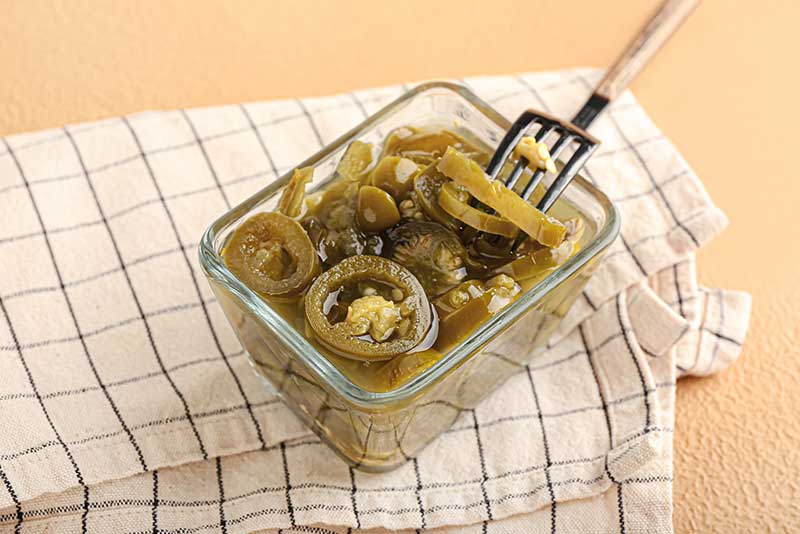
Ingredients:
- 1 cup jalapenos, sliced
- 2 cloves garlic, minced
- 1 tbsp sea salt
- Filtered water
Instructions:
- Mix together the sliced jalapenos, garlic, and sea salt in a large jar.
- In a separate bowl, dissolve the sea salt in filtered water to create a brine solution.
- Pour the brine over the jalapenos in the jar, covering them fully.
- Cover the jar with a lid or cheesecloth and leave it at room temperature for 3–5 days, or until the jalapenos reach your desired level of tanginess.
- Store the pickles in the refrigerator to further slow down the fermentation process.
7. Fermented Radishes
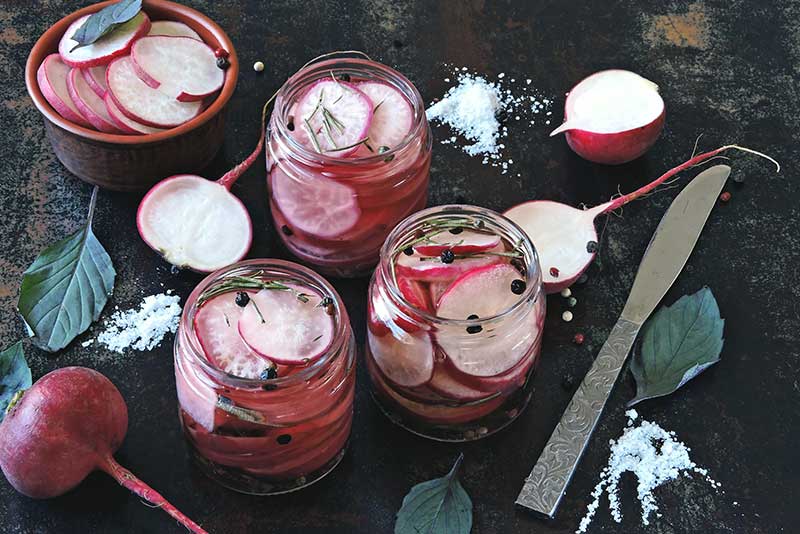
Ingredients:
- 1 bunch radishes, sliced
- 2 cloves of garlic, minced
- 1 tbsp ginger, grated
- 1 tbsp sea salt
- Filtered water
Instructions:
- Mix together the sliced radishes, garlic, ginger, and sea salt in a large jar.
- Also, in a separate bowl, dissolve the sea salt in filtered water to create a brine solution.
- Pour the brine over the radishes in the jar, making sure they are fully covered.
- Cover the jar with a lid or cheesecloth and leave it at room temperature for 3–5 days, or until the radishes reach your desired level of tanginess.
- Store the pickles in the refrigerator to further slow down the fermentation process. In order to get the same flavor as K-dramas, you need to try this fermented pickle recipe.
Takeaway
Fermented pickles are a great addition to your diet as they are full of beneficial bacteria that help support gut health. These 7 healthy and delicious fermented pickle recipes are easy to make and also provide a variety of flavors to suit any taste. Whether you prefer spicy, tangy, or sweet, there is a recipe for everyone.
When making fermented pickles, it is important to use high-quality ingredients and follow proper fermented food safety guidelines. Also, it is imperative to use clean jars and utensils and make sure your vegetables are fully submerged in the brine solution to prevent spoilage. If you notice any signs of mold or an off odor, discard the pickles and start over with fresh ingredients.
References
https://www.tandfonline.com/doi/abs/10.1300/J044v03n02_08

Mrs. Pushpa Khurana is a remarkable academic and culinary expert who has excelled in both education and cooking. Her academic Read more


